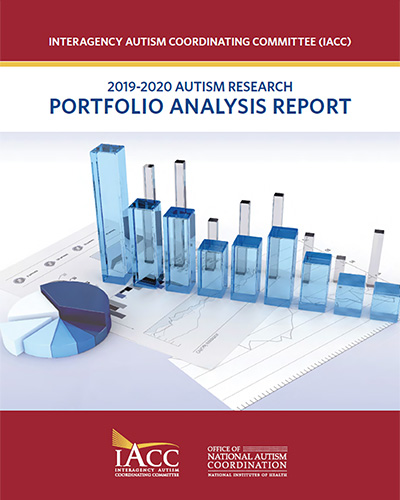March 7, 2024 | For Immediate Release
Release of the 2019-2020 IACC Autism Research Portfolio Analysis Report

The 2019-2020 IACC Autism Research Portfolio Analysis Report was released by the Interagency Autism Coordinating Committee (IACC) to provide an analysis of research funding activities across the United States. It is the ninth in a series of IACC portfolio analysis reports, the first of which was released in 2008, to track autism research funding of federal agencies and private research organizations across the United States. The reports provide comprehensive information about U.S. autism research funding to the IACC, a federal advisory body, to help in its efforts to monitor autism research progress and trends. This information is also used by advocacy organizations, government agencies, private funders, and the broader autism community to understand the autism research funding landscape.
The 2019-2020 IACC Autism Research Portfolio Analysis Report includes project information collected from 30 federal and private funders. Funding for autism research among both federal and private organizations totaled $424.2 million and spanned 1,604 projects in 2019. Funding in 2020 totaled $418.9 million and spanned 1,573 projects. Overall funding for autism research increased by 7.6% ($30.0 million) from 2018 to 2019. From 2019 to 2020, total autism funding decreased by 1.2% ($5.3 million). Similar to previous years, federal agencies funded approximately 80% of autism research while private organizations contributed nearly 20% of funding.
Over the years of portfolio analysis tracking, fluctuations in funding have been observed, which can result from factors such the pattern of project/initiative start and end dates, changes in organization budgets and priorities, changes in government appropriations, and the effects of using certain funding mechanisms, some of which can create an uneven pattern. In this Portfolio Analysis Report, a decrease in funding was observed from 2019 to 2020; the aforementioned factors may have contributed. It is also important to note that the decrease in 2020 funding levels coincided with the start of the coronavirus disease 2019 (COVID-19) pandemic. Research across many scientific disciplines was affected by the pandemic, as has been documented in the scientific literature, and autism research may have been similarly impacted. Monitoring of the 2021 and 2022 funding cycles in future Portfolio Analysis Reports will shed further light on variations in funding levels and the overall trajectory of growth of autism research in recent years.
In addition to analyzing overall funding trends, the report aligns 2019 and 2020 data on individual research projects with Objectives in the 2016-2017 IACC Strategic Plan, providing an account of how much funding has supported projects related to Strategic Plan Objectives. Every Objective in the 2016-2017 Strategic Plan had associated projects and funding in 2019 and 2020. This indicates that the priority areas identified in the IACC in the Strategic Plan were also high priority for federal and private research funders, who supported projects in those areas.
As in previous years, research on the Biology of autism continued to be the largest area funded (45% of total funding in 2019 and 2020), followed by Genetic and Environmental Factors (19% in 2019, 18% in 2020). Funding for Infrastructure and Prevalence (10% in 2019, 9% in 2020) and Interventions (11% in 2019, 9% in 2020) followed. Funding in the areas of Lifespan (4% in 2019 and 2020), Services and Supports (5% in 2019, 8% in 2020), and Screening and Diagnosis (5% in 2019, 7% in 2020) maintained funding levels or increased from 2019 to 2020. The areas with the most growth from 2019 to 2020 were Screening and Diagnosis and Services and Supports. In the next iteration of the Portfolio Analysis Report, funding levels will continue to be analyzed to determine whether they maintain trajectories of growth.
This report represents the twelfth and thirteenth years of data collected and the ninth comprehensive report of U.S. autism research funding across both federal and private sectors. In addition to the full report, a new accompanying "At-a-Glance" summary provides an overview of the key findings of the report.
In addition, detailed federal and private organization project data are available in the Autism Research Database, accessible via the IACC website. This database provides the community with a centralized place from which to gather valuable information about autism research that can support their efforts to serve autistic people and their families.
The IACC and the Office of National Autism Coordination are grateful to participating funders whose data contributions to the portfolio analysis effort made this report possible.
***
The IACC is a federal advisory committee that was created by Congress in order to accelerate progress in autism research and services. The IACC works to improve coordination and communication across the federal government and work in partnership with the autism community. The Committee is composed of officials from many different federal agencies involved in autism research and services, as well as adults on the autism spectrum, parents and family members of individuals on the autism spectrum, advocates, researchers, providers, and other public stakeholders. The documents and recommendations produced by the IACC reflect the views of the Committee as an independent advisory body and the expertise of the members of the Committee but do not represent the views, official statements, policies, or positions of the federal government. For more information on the IACC, please visit: iacc.hhs.gov.


